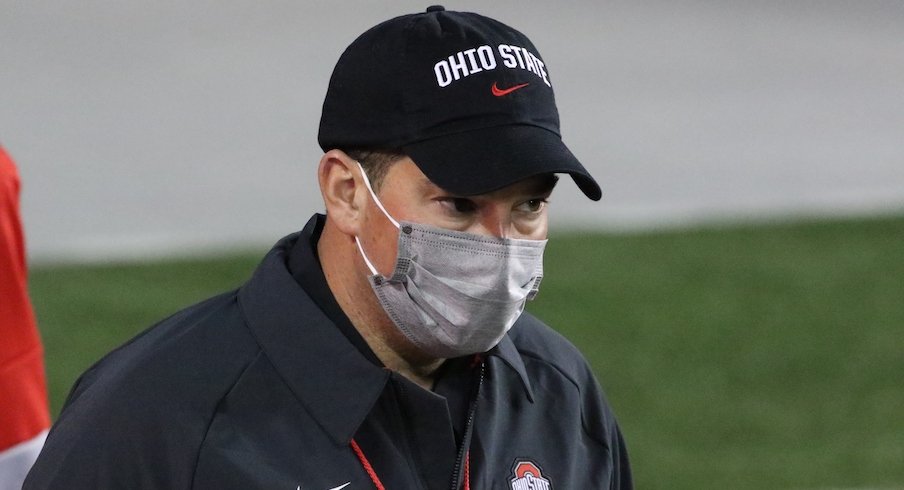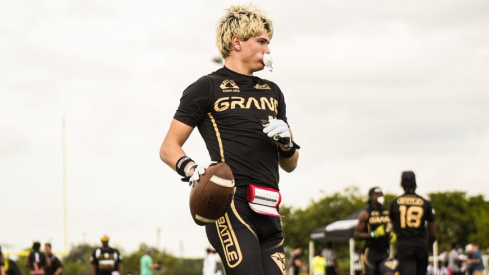Ohio State made it through the first three games of its already shortened 2020 season without any major issues related to the COVID-19 pandemic.
While Ohio State has not publicly disclosed its testing results for the football program, there have been no indications of any significant COVID-19 outbreaks within the team since the season started. Other than Justin Hilliard, whose initial positive test at Penn State was ultimately determined to be a false positive by a PCR test, none of the Buckeyes’ other key players have been sidelined as a consequence of the virus.
Ryan Day and the rest of Ohio State’s coaching staff have emphasized the importance of everyone in the program doing whatever they can to protect themselves against COVID-19 on a day-in, day-out basis, and so far, that’s seemingly worked for the Buckeyes.
“I don’t know if you could reinforce anymore than what Coach Day has already told us,” Ohio State offensive tackle Nicholas Petit-Frere said last month. “From day one, even during quarantine, from that moment on, we’ve been like, we have to be careful around the people we’ve been around. We have to treat almost like everyone has the virus.”
Justin Fields said Wednesday he hasn’t been going anywhere except the Woody Hayes Athletic Center and occasional trips to the grocery store as he tries to avoid contracting COVID-19. Some coaches with school-aged children haven’t even been staying at their own homes as they try to limit their potential exposures to the virus. Because the Buckeyes are so motivated to have a chance to compete for a national championship, players and coaches have made unusual sacrifices to try to keep themselves and their teammates healthy and on the field.
But even if Ohio State continues to elude the virus, which is far from guaranteed no matter how careful the Buckeyes are being, they’re also at the mercy of other factors that are completely out of their control, including whether their opponents stay healthy.
Ohio State was hit with that reality on Wednesday, when Maryland announced that it had paused all team activities after eight football players tested positive for COVID-19, resulting in the cancellation of the Buckeyes’ fourth game of the season that was scheduled to be played on Saturday.
Suddenly, Ohio State’s margin for error for the remainder of the season has gotten smaller. The Maryland game won’t be rescheduled, bringing the Buckeyes down to just seven regular-season games. Unless the average number of games played by teams around the conference falls below six, Ohio State must play at least six games to make the Big Ten Championship Game, meaning that any additional cancellations could put the Buckeyes’ aspirations of defending their conference title on thin ice.
As the third-ranked team in the country, Ohio State should still be positioned to make the College Football Playoff if it wins all of its regular-season games. One less game on its regular-season schedule, though, certainly decreases the likelihood that the Buckeyes would still have a path to the playoff if they don’t go undefeated.
Given all of that, Ohio State likely would have explored the possibility of scheduling a replacement game for this week if it was allowed to. The Big Ten already ruled that teams would not be allowed to schedule replacement games against non-conference opponents this season, however, after Nebraska already tried to do that when Wisconsin had to cancel its scheduled game against the Cornhuskers two weeks ago.
Of course, all of this goes back to the Big Ten’s initial decision not to start the season until Oct. 24, leaving the conference with no bye weeks and no flexibility to reschedule games. While Ohio State athletic director Gene Smith and others around the conference expressed optimism at the time that the Big Ten’s daily testing protocol would limit the need to cancel games, this is now the third Big Ten game that’s been canceled in four weeks, along with Wisconsin’s games against Nebraska and Purdue.
Day acknowledged last week that it is a small victory every time the Buckeyes are just able to play a game, given that COVID-19 numbers are currently on the rise throughout the country and the pandemic remains as much of a threat to the season as ever.
“It’s week-to-week, it’s day-to-day, for sure,” Day said. “And you hold your breath all week, you hold your breath the day of.”
The Buckeyes have known all along that this was a possibility, and they can’t let one midseason cancellation distract them from their own focus on staying healthy and continuing to prepare for the rest of their games. Ohio State still practiced on Wednesday even after the game cancellation was announced, and it’s a safe bet that Day and the rest of the staff will put even more emphasis on staying safe over the next few days now that they know their players will have some unexpected free time this weekend.
#GoBuckeyes pic.twitter.com/ge9Gv56DUT
— Ohio State Football (@OhioStateFB) November 11, 2020
Day knows the Buckeyes can’t afford to let their guard down, or celebrate any victories over the virus too soon, as it has the potential to derail their season at any time.
“That’s what I say to (the team): You guys may get tired of hearing it from me, and you may not wanna hear it every day. But the minute you take a deep breath, the minute I don’t bring it up, it takes one day. It takes one trip to a restaurant, one trip to the grocery store where you don’t have a mask on, somebody you’re exposed to, a friend or something like that, and then you’re at risk,” Day said in October. “And then you’re not playing for three weeks, and then you put the team at risk. We can’t have that mentality. We have to stay alert and stay on it every day.”
Day, like Urban Meyer before him, has always been one to preach that the Buckeyes need to focus on what they can control, and that’s not going to change. Wednesday’s news was a harsh reminder, though, that there’s only so much Ohio State can control in regards to the pandemic’s impact on its season.


